
Editor’s note: This guest blog, written by Karlee Pringle and Samantha Lau, MScOT, occupational therapists in Ontario, Canada, discusses tools (assistive devices) to help people with Parkinson’s dress more safely and easily.
How can assistive devices help individuals with Parkinson’s disease with dressing?
Common symptoms of Parkinson’s such as tremors, involuntary movement (dyskinesia) or difficulty with balance can make dressing tasks such as putting on shirts, shoes and socks more of a challenge. Assistive devices can support individuals in maintaining independence and safety with dressing. Here, we highlight some common and inexpensive options that may help people living with Parkinson’s.
Long-handled shoe horn
A shoe horn is a device with a handle and a flared end that allows the user’s heel to slide down and into a shoe. This device was developed to prevent excessive bending and help individuals put on their shoes more easily. Long-handled shoe horns are made of plastic or metal and provide additional length in comparison to the traditional shoe horn. The long-handled design allows the device to be used from either a seated or standing position. It is recommended to use this tool when seated so you don’t have to balance on one foot when standing to put on each shoe. This can be especially helpful for people who have balance or low blood pressure problems.
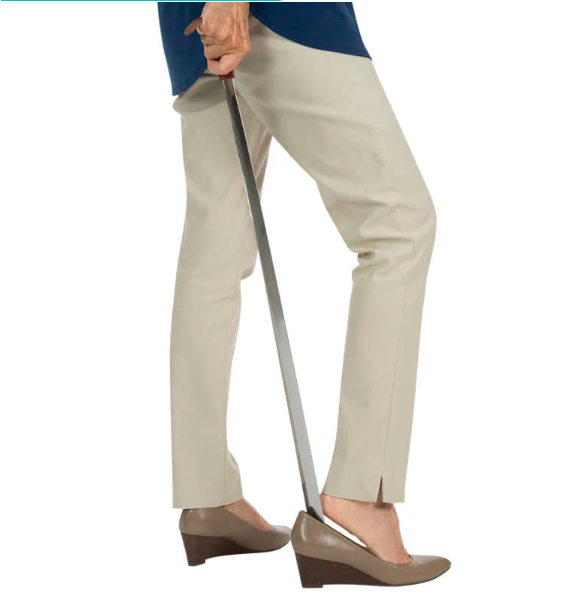
Sock aid
Sock aides are typically made of plastic and may be coated in fabric. Their use is similar to that of a shoe horn, in that the plastic piece allows the individual to slide their foot into a sock. The sock is placed around the end of the plastic component, and the individual uses the ribbon or strap to lower the sock to the floor. The person then places their foot at the opening of the sock and pulls up on the straps to slide the sock onto the foot. This tool allows an individual to put on their sock without having to balance while bending over or shifting side to side to put on each sock.
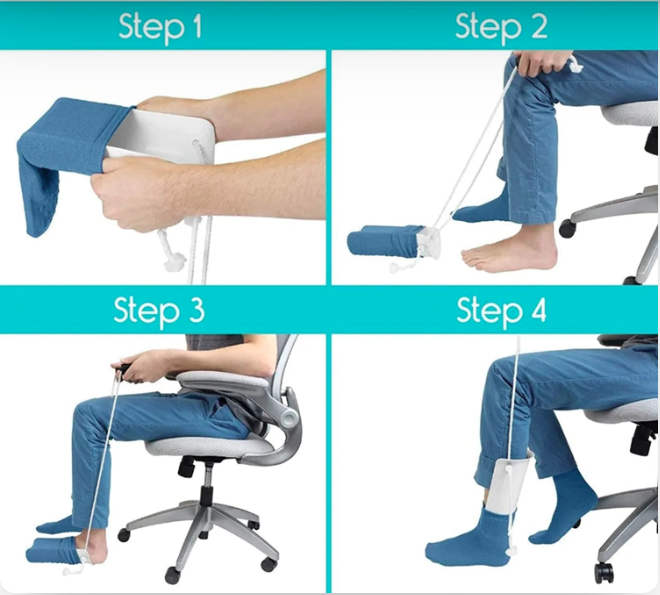
Compression stocking aid
For those who wear compression stockings (tight-fitting, high socks used to reduce swelling and promote circulation, especially in people with low blood pressure), similar aids are available that accommodate the tightness of the stocking. There are several compression stocking aids available that each vary slightly in design but maintain a similar purpose. In the image above, the device is made from steel and coated in smooth plastic. This allows the device to maintain a rigid frame to withstand the compression of the stocking. In the center, there is a U-shaped frame that widens the opening of the compression stocking, making it easier to put on. The person first places the stocking within the U-shaped frame, and then stretches the top of the stocking over the frame. The person will then continue to pull the stocking down the sides of the frame until the toe portion of the stocking is at the top of the frame. Once in place, the person will lower the device to the floor, place their foot at the top of the frame, and use the extended handles to pull the stocking onto their foot and leg. One potential challenge is that this tool requires a moderate amount of hand coordination and strength to use. Using an aid coated in fabric, especially silk, can help make it easier to use.
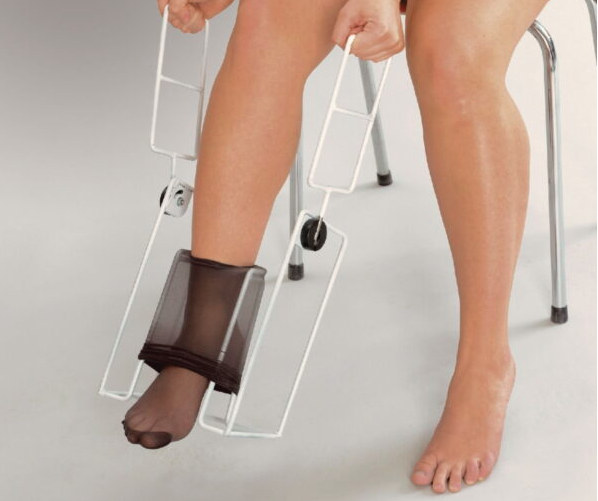
Elastic shoelaces
Tremors or trouble with fine motor movements can make it difficult to complete tasks that involve intricate hand movements or manipulating small objects. Tying shoelaces requires a significant amount of fine hand coordination. One alternative is Velcro shoes, but this can restrict the styles of shoe available. Elastic shoelaces are, as the name suggests, long strands of elastic that lace onto shoes the same way conventional shoelaces do. However, because they are elastic, the individual can simply slide their feet into their shoes. In combination with a long-handled shoe horn (see above), these shoelaces can make putting on shoes much simpler. This type of shoelace comes in a variety of styles, including coiled laces without clasps, or straight laces with metal clasps which only have to be clasped together when the shoes are initially laced. Elastic shoelaces can also reduce the risk of tripping on laces while walking, which can lead to falls.
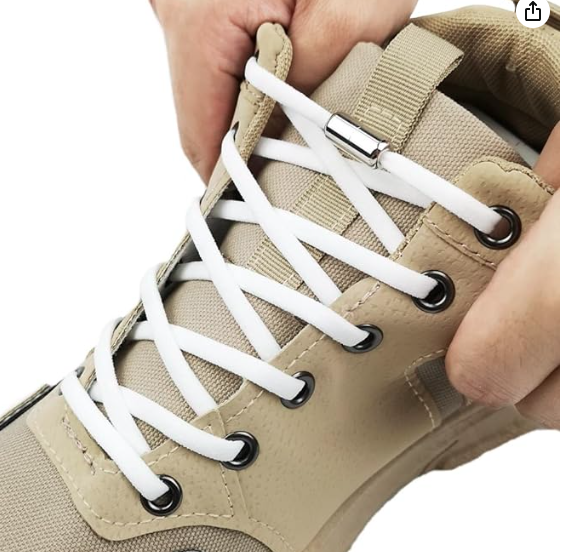
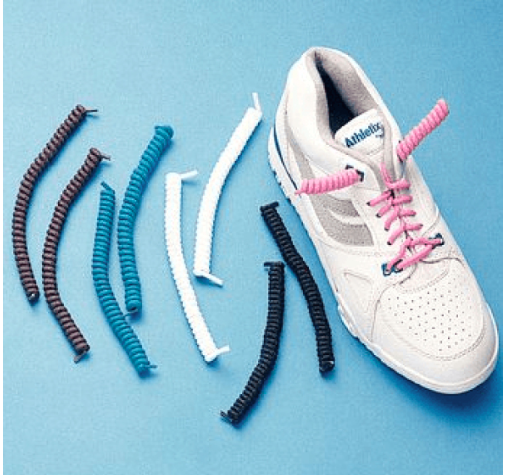
Front-fastening bra
For women who have trouble fastening a regular bra behind their back, switching to a front-fastening bra can be helpful. Front-fastening bras, as the name suggests, have clasps in the front, rather than the back, of the bra. Some even have zippers or snaps, instead of clasps, which require less coordination and dexterity. Or, you may be able to opt for a bra without a fastener, which simply slides over your head, to avoid challenges with fine finger and hand movements altogether.
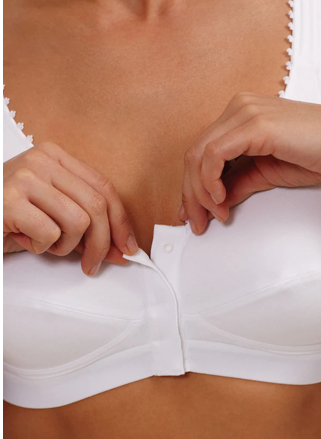
Dressing stick
A dressing stick is a multi-purpose tool that can be used for many parts of the dressing and undressing process. This device is made out of a wooden dowel with smooth plastic-covered hooks on either end. The c-shaped hook on the left side of the device can be used to hook belt loops to help pull on or take off pants. The hook can also be looped into a zipper to zip up sweaters and jackets. The s-shaped hook on the right side can be used for pulling on and pushing off shirts, sweaters, and jackets as well as pulling up or taking off pants. An occupational therapist can show you how to use a dressing stick with various types of clothing.
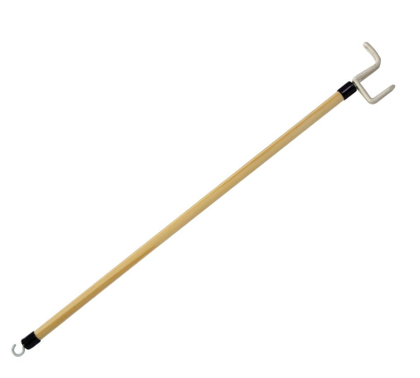
Reacher
Reachers are designed with a long metal bar, a finger trigger, and a claw, used for grabbing items. This device is another multi-purpose tool that is not exclusive to dressing tasks. Reachers can be used to grab clothing items from high shelves or to pick up items off the floor without significant bending or balancing. Reachers are also commonly used to bring pants to the floor, guide the pants onto your foot and leg, and then pull them up to your waist.
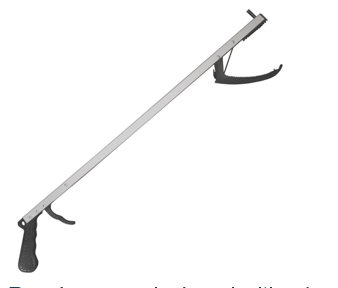
Ratchet belt
Ratchet belts are belts without holes. Rather than the traditional buckling system, these belts do not require an individual to place the belt prong in a hole to keep the belt tight and in place. Rather, this belt has a mechanism inside that allows the belt to be tightened by pulling, similar to a system used in zip ties. To use the device, you loop the belt through pant loops, as you typically would. The free end of the belt is then pushed through the opening in the belt buckle and pulled to tighten. When the appropriate tightness has been reached, the belt will automatically lock in place using notches in the belt buckle that have grasped onto the track on the back of the free end of the belt. To release, the face of the buckle is lifted or a lever on the bottom of the buckle is lifted.
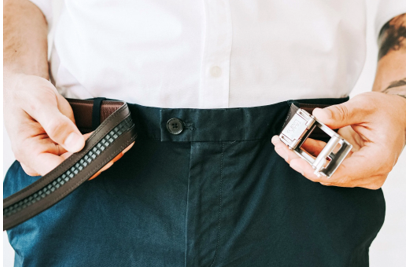
General tips
- Dress in a seated position, such as at the end of the bed or in a chair
This limits the chance of losing balance or falling while dressing. For example, putting on pants while standing requires single-leg balance as well as maintaining balance while bending down. - Consider adaptive clothing brands
Adaptive clothing is an innovation that is continuing to emerge and is starting to break through into bigger brands. This ranges from magnetic button-down shirts to wheelchair-friendly pants with button snaps on the legs. A simple online search can generate links to both online and in-person, local shops that carry adaptive clothing. - Work with occupational therapy
These experts specialize in helping you choose and use clothing and tools that best suits your lifestyle and your needs when living with Parkinson’s.
For more on this topic, watch a webinar featuring the authors.
To learn more about working with occupational therapy, check out MJFF’s blog.
References
- Belt [Online image]. (n.d.). Kore Essentials. https://www.koreessentials.com/blogs/news/what-is-a-ratchet-belt-3
- Coil elastic shoelaces [Online image]. (n.d). Stick Healthcare. https://goodplugsk.live/product_details/10097395.html
- Compression stocking aid [Online image]. (2023). Ability Store. https://abilitystore.co.uk/shop/living-aids/comfort-dressing-aids/compression-stocking-aid/
- Dressing stick [Online image]. (2023). Maxim Medical Supplies. https://maximmedical.ca/products/dressing-stick
- Elastic Shoelaces [Online image]. (n.d.). Amazon. https://www.amazon.ca/1Pair-Shoelaces-Elastic-Special-Shoelace/dp/B0B4GBQH1W
- Front-fastening bra [Online image]. (n.d.). Adaptawear. https://adaptawear.com/collections/front-fastening-bras
- Long-handled shoe horn [Online image]. (n.d.). Vive Health. https://www.vivehealth.com/products/long-shoe-horn?variant=13690173489187
- Reacher [Online image]. (n.d.). Halo Home Healthcare. https://halohealthcare.com/products/drive-medical-handheld-reacher?variant=4013997395157
- Sock aid [Online image]. (2023). Babaclick. https://babaclick.ca/products/cyrank-sock-aid-socks-helper-sock-puller-aid-easy-on-and-off-sock-aid-tool-and-pants-assist-for-elderly-disabled-sock-assist-device-for-elderly-1